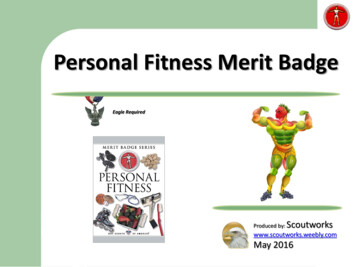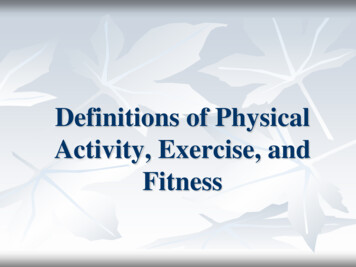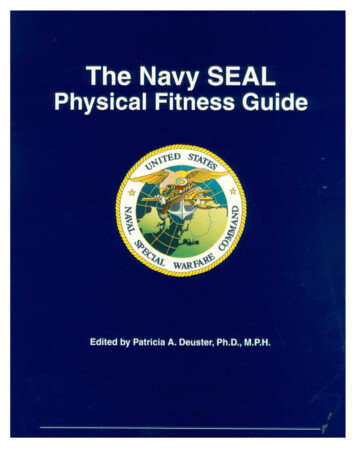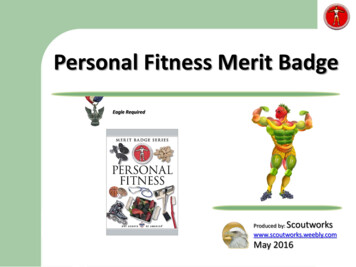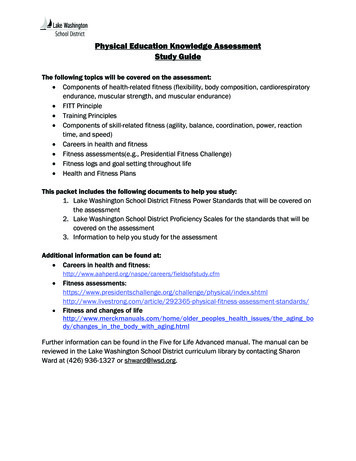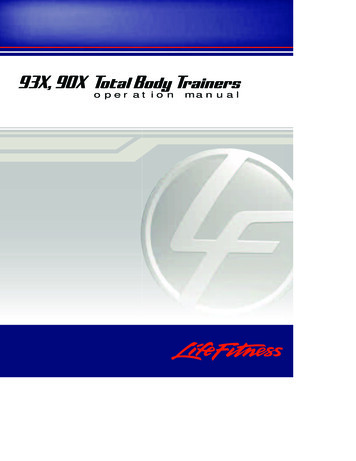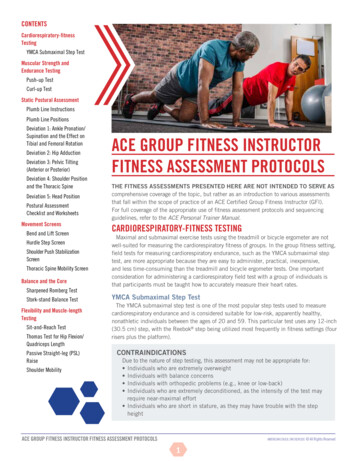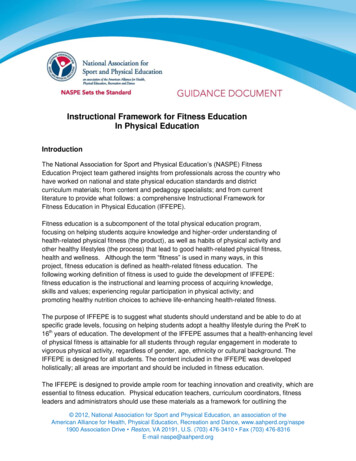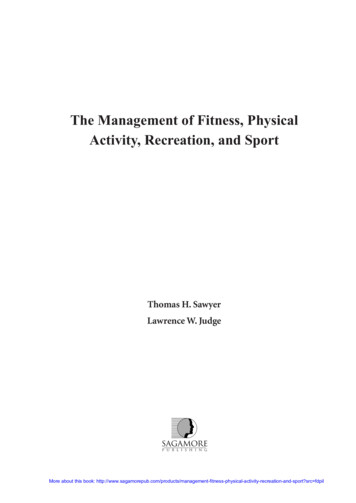
Transcription
The Management of Fitness, PhysicalActivity, Recreation, and SportThomas H. SawyerLawrence W. JudgeMore about this book: ness-physical-activity-recreation-and-sport?src fdpil
2012 Sagamore Publishing LLCAll rights reserved.Publishers: Joseph J. Bannon and Peter L. BannonDirector of Sales and Marketing: William A. AndersonMarketing Coordinator: Kacee ReynoldsDirector of Development and Production: Susan M. DavisTechnology Manager: Christopher ThompsonProduction Coordinator: Amy S. DagitISBN print edition: 978-1-57167-692-4ISBN ebook: 978-1-57167-693-1LCCN: 2012941422Sagamore Publishing LLC1807 N. Federal Dr.Urbana, IL 61801www.sagamorepub.comMore about this book: ness-physical-activity-recreation-and-sport?src fdpil
This book is dedicated to the future professions in fitness, physicalactivity, recreation, and sport, practitioners, and faculty who prepare thefuture professionals involved in fitness, physical activity,recreation, and sport programming.More about this book: ness-physical-activity-recreation-and-sport?src fdpil
More about this book: ness-physical-activity-recreation-and-sport?src fdpil
ContentsDedication.iiiAcknowledgments. viiForeword. ixPreface. xiAbout the Authors. xivPart 1Fundamentals of Fitness, Physical Activity, Recreation, and Sport12345678910Sport Management History (Sawyer).3Management Principles (Sawyer). 15Organizational Principles and Leadership (Sawyer). 31Ethical Decision Making (Bodey). 57Planning for Success (Sawyer). 67Programming for Success (Sawyer). 85Advocating for Success (Bodey). 97Managing Human Resources (Sawyer). 109Legal and Risk Management Principles (Sawyer). 127Compliance in College Athletics (Gimbert). 161Part 2The Fitness, Physical Activity, Recreation, and Sport Industries111213141516171819Club Industry (Sawyer). 177Recreational Sports Industry (Sawyer). 197Youth Sports in America (Judge). 213Interscholastic Athletics (Sawyer and Gimbert). 233Intercollegiate Sport Management (Judge). 253Elite Amateur Sports in America (Judge). 273Professional Sports in America (Judge). 299Campus, Community, and Military Recreation (Judge). 323Recreation and the Sporting Goods Industry (Sawyer). 333Part 3Financial and Marketing Principles2021Financial Principles (J. A. Hypes). 341Purchasing and Inventory Control Principles (M. G. Hypes). 359vMore about this book: ness-physical-activity-recreation-and-sport?src fdpil
222324252627Revenue Generation (Sawyer). 375Marketing Principles (Sawyer and J. A. Hypes). 397Retail Principles (Sawyer). 411Sales, Sponsorships, and Licensing Principles (Sawyer and J. A. Hypes). 431Fund-Raising Principles (Sawyer). 445Customer Retention Principles (Sawyer). 451Part 4Facility Design and Event Management282930Facility Design Principles (Sawyer, M. G. Hypes, and Gimbert). 469Event Planning Principles (Sawyer and Gimbert). 489Volunteers: The Key to Successful Event Management (Sawyer). 519Part 5Communication and Media Relations313233Communication Principles (M. G. Hypes). 533Media Relations Principles (J. A. Hypes). 541Public Relations Principles (Sawyer and M. G. Hypes). 547AppendicesABCDSample Booster Club Articles of Incorporation. 557Sample Booster Club Bylaws. 560Sample Booster Club Constitution. 565Sample Booster Club Standard Rules. 567Index . 569viMore about this book: ness-physical-activity-recreation-and-sport?src fdpil
AcknowledgmentsThis manuscript would not have become a reality without the support of SagamorePublishing from Joe Bannon and Peter Bannon. The editorial staff has been very helpfuland a great assistance to me during the publishing process. A special thanks goes toSusan Davis and Amy Dagit for their working in editing and designing the book.The coauthors in this project—Dr. Kimberly Bodey, Ms. Tonya Gimbert, Dr. JuliaAnn Hypes, and Dr. Michael Hypes —were a delight to work with. They made our taskas editors-in-chief much easier. They are leaders in their own right in the professionthey serve.I decided that a coeditor for the book was essential since I am not getting anyyounger. I have selected a former student of mine to fill that position, Dr. Larry W.Judge. Larry is an up-and-coming professional who will be very capable of movingthis text forward in the future after I retire.viiMore about this book: ness-physical-activity-recreation-and-sport?src fdpil
More about this book: ness-physical-activity-recreation-and-sport?src fdpil
ForewordIn an era of the health and fitness entrepreneur, sport has become even more significantand pervasive in American society. Sport has become a multibillion-dollar industry thatplaces unique demands on its personnel and increasingly requires specialized training. Jobsin the sport industry involve a variety of skills applicable to the sport setting and specific tothe increasingly complex and multifaceted areas it represents. Sport management is nowrecognized by the sport industry as a legitimate profession and field of study in collegesand universities throughout the United States, Canada, and other sport-oriented countries;as a result, a new profession has arrived on the scene.In 2005, resources that addressed managing fitness, physical activity, recreation, andsport programs in the club environment were, and remain today, limited. Even thoughthe academic field of sport management has flourished since the mid-1980s, includingthe publication of numerous books related to the various aspects of the field as wellas a number of professional and trade journals, it is still difficult to find a book focusedon applying sport management theory to the rapidly growing club market. Clubs needappropriately prepared young men and women to manage the various programs in orderto be successful in this very competitive industry.In order to appropriately prepare these young men and women to operate andmanage the fitness, physical activity, recreation, and sport programs of the 21st centurysuccessfully, there needs to be resources available to instruct and prepare them. Ourpresent and future fitness, physical activity, recreation, and sport managers need to knowhow to identify and foster the four issues that are vital for the survival of any facility housingthese activities. These issues are human resources; sound financial principles; the market;and facility planning, design, and maintenance as well as the management of these typesof facilities.The first and most important issue is human resources. Part 1 provides a broad andrich perspective on three central human resource issues: the selection and training ofpersonnel, the coordination and planning of operations, and the all-important developmentof programs, which are the lifeblood of every facility.The second issue, so often overlooked in other texts, is the fitness, physical activity,recreation, and sport market. No matter how talented the personnel or how well theenterprise is capitalized, if the market is not prime, the business will never completely fulfillits potential. Sawyer and Judge do a brilliant job explaining to the readers how to analyzeand communicate with the market to ensure success regardless of the market situation.The third issue that needs to be effectively managed in every athletic and fitness facilityis sound financial management principles. These principles are the budgeting process,the enterprise of revenue generation, the challenge of effective promotion, the issue offund-raising, the supreme task of generating repeat business (membership retention), andpurchasing issues. In Part 3, Sawyer and Judge focus on these financial factors and forcesthat determine the success or failure of every sport facility business.The fourth and final issue to be considered is the facility itself. The authors excelin raising and exploring the central issues relating to facility development, facilitymanagement, the legal issues relating to the operation of the facility, and the managementof the risks inherent in operating an athletic or fitness facility.ixMore about this book: ness-physical-activity-recreation-and-sport?src fdpil
Sawyer and Judge do an excellent job presenting the information in this book in anopen, accessible, clear, and compelling manner that raises all the right questions andinvites deeper exploration.This book is tailored around the informational needs of future sport and recreationalsport professionals who will be involved in managing professional sport, recreation, andsport facilities, campus recreation programs, community-based sport programs, sport clubs,health and fitness clubs, aquatic facilities, and nonprofit youth agency sport programs.This text is ideally suited to classroom discussion and exploration because it raises theissues surrounding the management of fitness, physical activity, recreation, and sportfacilities in an open and accessible way.Furthermore, this book not only introduces the students to a variety of management,marketing, financial, and legal concepts related to sport, but it also shows studentshow to apply the concepts in real-life situations. Sawyer provides both educators andstudents with a wonderfully flexible and adaptable teaching tool that brings to life theentire enterprise of recreation and sport facilities.Dr. Richard LaRue, NAS FellowProfessor of Sport ManagementFormer Chair of the Council of Facilities and EquipmentFormer Board of Governor for AAHPERDUniversity of New EnglandBiddeford, MainexMore about this book: ness-physical-activity-recreation-and-sport?src fdpil
PrefaceIn an era of great expansion, sport has become even more significant and pervasive inAmerican society. Sport is defined as those activities that have the following characteristics:(a) it is competitive, (b) it has scoring, (c) it has rules, (d) it is played by amateurs and/orprofessionals, (e) it is played indoors and outdoors, (f) it has components of both fitnessand recreation, (g) it provides the participants enjoyment and fun, and (h) it providesentertainment for the spectator. Sport is used in this book in a very broad sense as an“umbrella term” encompassing the ever-growing areas of amateur and professional sportas well as all activities of the fitness and recreation industry. Sport is a multibillion-dollarindustry ranging from fitness, recreation, and sport activities to retail sales and entertainment.This growing industry places unique demands on its personnel and increasinglyrequires specialized education. The job requirements in the sport industry involvemany skills applicable to the sport setting and specific to the increasingly complex andmultifaceted areas it represents. This text provides the reader with enough information ona variety of subjects to know where to proceed without assistance and when it would bewise to seek additional professional assistance.Since the early l970s, a new breed of specialists has emerged—the sport manager.Sport management is now recognized as a legitimate field of study in colleges anduniversities worldwide. In its broadest sense, sport, sport programs, and sport managementare terms used to encompass other terms such as activity-based programs, fitnessprograms, recreation programs or club management, fitness management, and recreationmanagement. Therefore, throughout this text the umbrella term will be sport management.Settings for the management of fitness, recreation, and sport activities fall intofive primary clusters, each of which contains two or more categories that have similarobjectives and provide similar services, but occur in different settings and/or servedifferent clientele.1. Sport for leisure and recreational settings include organizations that provide facilitiesand programs for organized sport or fitness participation of members, includingcollege and university intramural sport clubs, corporations and companies withsport or fitness programs, private clubs, and public sport clubs.2. Sport and athletic settings include organizations that provide management ofsporting events, athletes, and/or spectator use, including college and universityathletics, professional sport, sport organizations, amateur sport, and sport managementservices.3. Sporting goods industry settings include businesses that develop, distribute, and/orpromote the sale of sport, recreation, and fitness equipment or clothing, includingsport marketing, sport merchandising, and retail sales.4. Settings include businesses that provide lodging and include recreation or leisureprograms and/or facilities for their clientele, including hotel, resorts, and travel orcruise businesses.5. Agency or club settings include organizations (agency) that use nonprofit fundingsources and clubs (for-profit organizations) to develop, implement, and manage fitness,recreation, or sport programs, activities, or facilities to meet the needs of the agencyor club members or population of governmental districts (e.g., city, county, state,xiMore about this book: ness-physical-activity-recreation-and-sport?src fdpil
federal), including local government agencies, federal government agencies, voluntaryagencies (e.g., YMCA, YWCA, Boys Club, Girls Club, Boy Scouts, Girl Scouts, healthand fitness clubs, and racquet clubs).A major concern for higher education and practitioners is the lack of a variety oftextbooks and related resources in this expanding field of study. Some texts are generalized,and others are specific. The Management of Fitness, Physical Activity, Recreation, andSport is a comprehensive compilation of concepts and practical subject matter publishedfor the fitness, physical activity, recreation, and sport management student and practitioner.AudienceAn increasing number of students with a wide variety of backgrounds are selectingsport management as a course of study at both the undergraduate and graduate levels.The intention of this book is to cater to this changing and rapidly growing audience.Furthermore, this book has been written for an introductory class or an upper division course,such as a capstone course. Students using this text will have a fundamental understandingof basic finance, basic management, basic marketing, and computer utilization. This bookwill also be a valuable resource for practitioners. Instructors at other levels are encouragedto review the content for potential use as well.Features ContentThis book has been designed as a textbook as well as a practitioner’s how-to book.The content focuses on those activities that are the most important for a club manager,recreational sport manager, or competitive sport manager. Each chapter providesexplanations of various management concepts important for the student to understandand how-to information that applies the concepts to realistic situations.The manuscript is divided into four major parts: (a) managing human resources andthe planning process, (b) financial management, (c) marketing, and (d) facility and riskmanagement.Each major part is divided into chapters. Part 1, Chapters 1 to 10, focuses onfundamental management principles related to leadership, organization, ethical decisionmaking, planning, programming, advocating, human resources compliance, and legal andrisk management. The second part, consisting of Chapters 11 to 19, covers the fitness,physical activity, recreation, and sport markets including the club industry; recreationalsports industry; youth sports; interscholastic athletics; intercollegiate athletics; eliteamateur sports; campus, community, and military recreation; and recreation and sportinggoods industry. Part 3, Chapters 20 to 27, focuses on financial and marketing principles.The fourth part, Chapters 28 to 30, covers planning and designing facilities and facilityand event management. The final part, Chapters 31 to 33, focuses on communicationprinciples, media relations, and public relations. The end of the manuscript contains 26appendices providing many sample documents from a business plan to a marketing planto a strategic plan to a facility design program book.Supplemental Materials for InstructorsThe following will be provided online for the instructors:Instructor GuideChapter introductionsInstructional Objectives for each ChapterKey Terms for each ChapterTwenty Questions and Answers (multiple choice and true and false)Essay questionsxiiMore about this book: ness-physical-activity-recreation-and-sport?src fdpil
Case StudyInternet ExercisesPowerPointsEach chapter will have PowerPoints that can be customized by the instructorSample Course SyllabusAuthor’s Philosophy as it Relates to Sport ManagementManagement is a process of achieving desired results through efficient utilizationof human and material resources by employing managerial functions such as planning,organizing, staffing, leading, and controlling. Furthermore, the process of management isbasically the same for all activities, whether it be business, government, education, fitness,recreation, or sport. Therefore, when one teaches the basic tenets of management, it appliesto all fields of endeavor—management is management. The only thing that changes inmanagement is how it is applied to the specific circumstances. The five basic managementfunctions must still be applied—planning, organizing, staffing, leading, and controlling—ifthe efficient utilization of human and material resources is to be the end result.xiiiMore about this book: ness-physical-activity-recreation-and-sport?src fdpil
About the AuthorsThomas H. Sawyer, Ed.D., NAS FellowProfessor of Kinesiology, Recreation, and SportDepartment of Kinesiology, Recreation, and SportIndiana State UniversityThomas Sawyer is a 42-year veteran of higher education.He began as an instructor of health and physical education;has been a director of recreational sports, departmenthead, department chair, associate athletic director, directorof articulation and transfer, director of a college prisoneducation program, executive director of regional education centers, and an interimdean of continuing education; and is ending his career, by choice, as a full professorteaching sport management theory to undergraduate and graduate students.He has written over 193 peer-reviewed articles for notable professional journals;made over 250 state, regional, national, and international presentations; and written 10professional books and over 32 chapters in other publications.He has served as a state AHPERD president (Indiana), district vice president(Midwest), association president (AAALF), chaired numerous district and nationalcommittees, editor of the Indiana AHPERD Journal and newsletter, chaired theJOPERD Editorial and Policy Boards, and is a member of the AAHPERD BOG. Hehas been an AAHPERD member since 1964.Dr. Sawyer has also been active in the community serving as a volunteer for theAmerican Red Cross in four communities in four different states since 1964. He hasbeen a first and CPR, and water safety instructor (over 30 years); a chapter boardmember (off and on for 30 years); chapter chairperson (off and on for 8 years); chair ofa state consortium (3 years); chair of numerous regional committees; and current chairof the Great Lakes Region, Service Area 5, Resource Council.Dr. Sawyer has received numerous awards for his leadership and service to theAmerican Red Cross; YMCA; a regional alcohol and drug consortium; Council onFacilities and Equipment; Indiana AHPERD; American Association for ActiveLifestyles and Fitness; American Alliance for Health, Physical Education, Recreation,and Dance; and Indiana State University. Furthermore, he has received Caleb MillsOutstanding Teaching Award, Faculty Distinguished Service Award, and DistinguishedResearch and Service Award from Indiana State University and the HowardRichardson’s Outstanding Teacher/Scholar Award from the School of Health andHuman Performance at Indiana State University.xivMore about this book: ness-physical-activity-recreation-and-sport?src fdpil
Lawrence W. Judge, Ph.D., CSCSAssociate Professor of Physical EducationBall State UniversityLawrence Judge serves as the coordinator of the AthleticCoaching Education program and has also served as theundergraduate advisor for the Sport Administration program.As both an associate head coach and head coach, Larry has atotal of 18 years work experience coaching Division I track andfield/cross country. In addition to field experience (training 8 Olympians and 10 NCAAChampions and coaching over 100 All Americans), Judge has firsthand knowledge ofNCAA rules and current issues in amateur, intercollegiate, and professional athletics.Widely recognized as the premier track and field throws coach in the United States,Larry Judge completed his collegiate coaching career with the University of Florida in2005. Under Judge’s direction, the Florida throws group has reached the pinnacle of thesport, amassing unparalleled honors. In just five years at UF, Judge has tutored eightAll-Americans, five Southeastern Conference Champions, two NCAA champions,and three Olympians, adding to an already impressive résumé. Gator throwers havecollected an astounding 34 All-American honors, 16 individual SEC titles, and sixindividual NCAA titles since Judge›s arrival in Gainesville prior to the 2000–2001season. In 2005, Judge capped off a stellar career at the University of Florida with fourformer Gator athletes competing in the world championships in Helsinki. Judge servedas an assistant coach for Trinidad and Tobago.Judge has guided eight athletes in the last three Olympic Games. In 2000, fiveof his former athletes competed in the 2000 Olympic Games in Sydney, Australia.Dawn Ellerbe was Judge’s top finisher in the games finishing seventh in the hammerthrow with a distance of 219-1. In 2004, Judge served as an assistant coach forTrinidad and Tobago in Athens and watched as three of his Gators competed, CandiceScott for Trinidad and Tobago, Kim Barrett for Jamaica, and Erin Gilreath for theUnited States. In 1997, Judge administered an Olympic Solidarity Clinic in PagoPago, American Samoa, and in 1999, conducted a NCAA Y.E.S. clinic at the IndoorNational Championships in Indianapolis. Judge is now working as a throws consultantfor U.S. Paralympics. He personally coached two medalists in the 2011 IPC WorldChampionships in Christ Church New Zealand and will serve as an assistant coach forthe U.S. team for the 2012 Paralympics in London.As a scholar, Dr. Judge has coauthored 52 peer-reviewed publications, including21 first-author publications in prestigious journals such the International Reviewfor the Sociology of Sport, Journal of Strength & Conditioning Research, and theInternational Journal of Sports Science & Coaching. Dr. Judge has also been active inthe area of textbook publishing, contributing 12 textbook chapters. In 2008, Dr. Judgecoauthored the textbook, Sport Governance and Policy Development: An EthicalApproach to Managing Sport in the 21st Century and authored the books The CompleteTrack and Field Coaches’ Guide to Conditioning for the Throwing Events and TheShot Put Handbook. He is currently a contributing author for a resource book in thedesign and planning of sport and recreational facilities. He has also given 84 peerreviewed academic presentations at a wide variety of state, national, and internationalconferences, while also acquiring 118,425 in grant funding from 11 internal (5) andxvMore about this book: ness-physical-activity-recreation-and-sport?src fdpil
external (6) sources that have primarily focused on cultivating healthy lifestyle habitsfor children through physical activity and the study of fair play as a social constructin sport. In regards to leadership roles in organizations outside Ball State, Dr. Judgecurrently holds the following positions: (1) Vice President of the Indiana Associationfor Health, Physical Education, Recreation, and Dance Sport Council; (2) Past Presidentfor the National Council for the Accreditation of Coaching Education; (3) Chair for theAmerican Alliance for Health, Physical Education, Recreation, and Dance Council onFacilities and Equipment; and (4) National Chairman of the United States Track andField Coaches Education for the Throwing Events. Dr. Judge serves as a level II andlevel III instructor in the IAAF coach’s education program and also lectures in theProfessional Figure Skaters Association nationwide coach’s education program. Dr.Judge serves on the editorial board of The Physical Educator and Techniques Magazine.Kimberly J. Bodey, Ed.D.Associate Professor, Kinesiology, Recreation, and SportIndiana State Universitysport experience.Kimberly J. Bodey has taught graduate andundergraduate courses in administrative theory andmanagement practice, organizational leadership and ethics,and policy development and governance in recreationand sport management. Currently she is working onspecial projects related to training youth sport coaches towork with athletes with hidden disabilities. Her researchinterests include training sport administrators and coacheson how to incorporate life skill development in the youthTonya Gimbert, M.S.Compliance CoordinatorDepartment of Intercollegiate AthleticsIndiana State UniversityTonya Gimbert received a bachelor of science (2003)in Elementary Education from Saint Mary-of-theWoods College and a master of science in Recreation andSport Management (2009) with a concentration in sportmanagement from Indiana State University. She is currentlyworking on a Ph.D. in Curriculum, Instruction, & MediaTechnology, with a concentration in teaching of Sport Management. She currentlyworks in the Department of Intercollegiate Athletics as the NCAA ComplianceCoordinator. Gimbert has served as an Adjunct Faculty member in the Department ofKinesiology, Recreation, and Sport as well as Athletic Academics. She currently servesas President of the Graduate Student Association and as student representative to thePresident’s Council. Gimbert has given presentations at professional conferences andauthored articles found in professional journals concentrating on sport management.xviMore about this book: ness-physical-activity-recreation-and-sport?src fdpil
Michael G. Hypes, DAAssociate Professor, Sport ManagementSchool of Business AdministrationMorehead State UniversityMichael Hypes has served as Chair for the Council forFacilities and Equipment, Vice-President for the IndianaCenter for Sport Education, Inc., Assistant Editor of theIndiana AHPERD Journal, Assistant Editor of the Journalof Le
health and fitness clubs, aquatic facilities, and nonprofit youth agency sport programs. This text is ideally suited to classroom discussion and exploration because it raises the issues surrounding the management of fitness, physical activity, recreation, and

